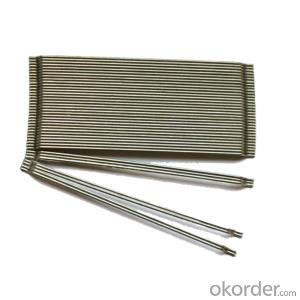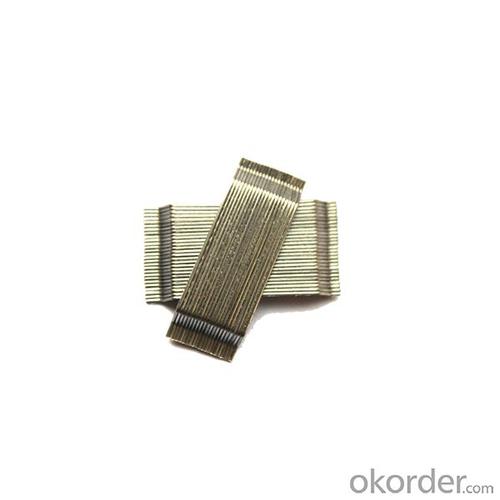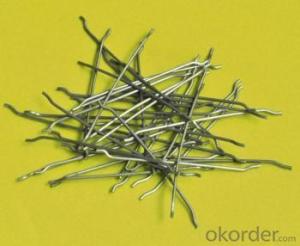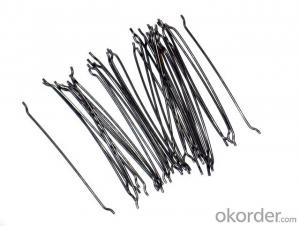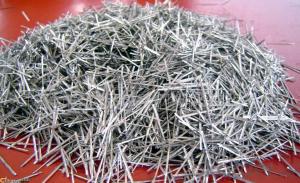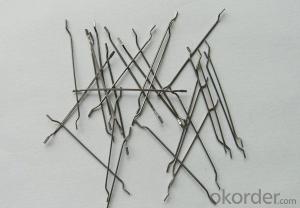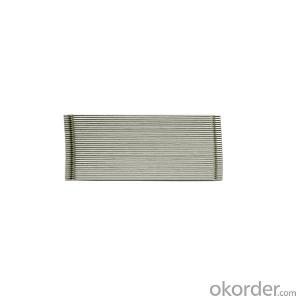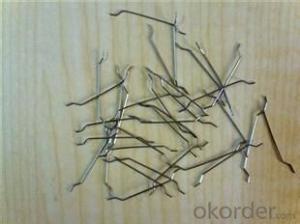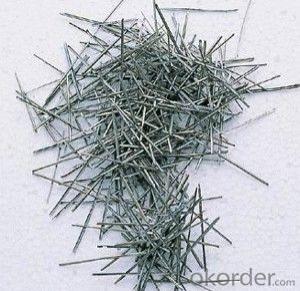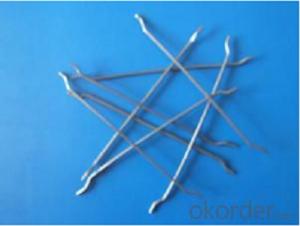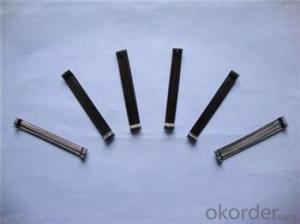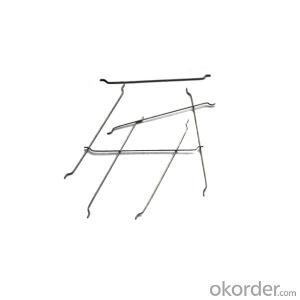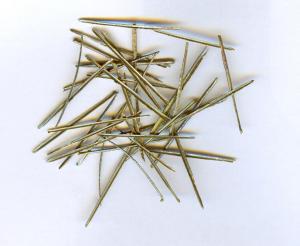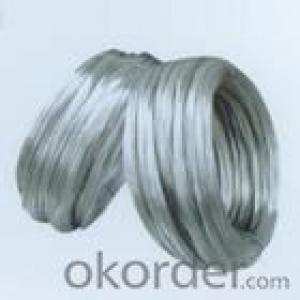Melt Extract Stainless Steel Fiber 0.75/30 Concrete Steel Fiber from CNBM China
- Loading Port:
- Tianjin
- Payment Terms:
- TT OR LC
- Min Order Qty:
- 1 m.t.
- Supply Capability:
- 5000 m.t./month
OKorder Service Pledge
Quality Product, Order Online Tracking, Timely Delivery
OKorder Financial Service
Credit Rating, Credit Services, Credit Purchasing
You Might Also Like
Quick Details
Place of Origin: Tianjin, China (Mainland)
Model Number: 0.75
Material: Steel
Production Process: Cold drawn
Lengh: 30
Type: 1
Compressive Strength: >1200MPa
Aspect ratio: 40
Standard: ASTM A820M-11
Section Shape: Circular
Application: Concrete Reinforcement
Packaging & Delivery
| Packaging Details: | 20 kg/Bag,50 bags/Pallet or 1,000kg/ Bulk Bag |
|---|---|
| Delivery Detail: | 1 Month |
Product Description
| Diameter | 0.75 | mm | 0.03 | in |
| Length | 30.00 | mm | 1.18 | in |
| Aspect Ratio | 40 | |||
| Tensile strength | 1200 MPa | |||
| Type | Cold drawn Steel Fiber | |||
| End | Hooked-end Steel Fiber | |||
| Glued/Loose | Glued Steel Fiber | |||
| Bending Angle | 45°(min.30°) | |||
| Usage & Performance | Floor:Trafficked areas and Industrial floors | |||
| Shotcrete :Slope stabilization and Final lining | ||||
| Precast concrete:Pipe and Railway sleepers | ||||
| Packing | Standard Export Pallet Packing | Bag Packing | 20 kg/Bag,50 bags/Pallet | |
| Bulk Packing | 1,000kg/ Bulk Bag | |||
| Loading Quantity | 20’GP | 20-25 Tonne/Tonnes | ||
| 40’GP | 25-27 Tonne/Tonnes | |||
| 40’HQ | 25-27 Tonne/Tonnes | |||
| MOQ | 1 kg for trial order | |||
| Supply Ability | 10,000 Tonne/Tonnes per Year | |||
| Payment Terms | T/T or L/C at sight | |||
| Delivery Time | Within 15 days after receiving deposit or original L/C at sight | |||
| Certification | ISO9001:2000, CE, | |||
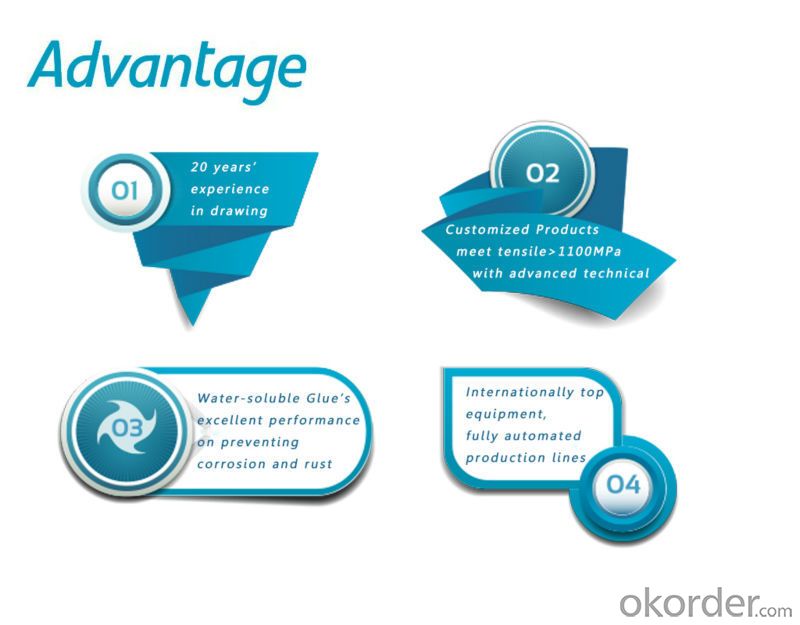
| Product | Diameter | Length mm/in | Aspect Ratio | Type | Packing |
| G-6030 | 0.5 mm (0.0197 in) | 30 mm (1.1811 in) | 60 | Glued | 20 kg/Bag, or 1,000kg/ Bulk Bag |
| G-6535 | 0.55 mm (0.0217 in) | 35 mm (1.3780 in) | 65 | Glued | 20 kg/Bag, or 1,000kg/ Bulk Bag |
| G-6035 | 0.6 mm (0.0236 in) | 35 mm (1.3780 in) | 60 | Glued | 20 kg/Bag, or 1,000kg/ Bulk Bag |
| G-8060 | 0.75 mm (0.0295 in) | 60 mm (2.3622 in) | 80 | Glued | 20 kg/Bag, 50 bags/Pallet |
| G-6060 | 0.9 mm (0.0354 in) | 60 mm (2.3622 in) | 60 | Glued | 20 kg/Bag, 50 bags/Pallet |
| G-6030 | 0.5 mm (0.0197 in) | 30 mm (1.1811 in) | 60 | Loose | 20 kg/Bag, or 1,000kg/ Bulk Bag |
| G-6535 | 0.55 mm (0.0217 in) | 35 mm (1.3780 in) | 65 | Loose | 20 kg/Bag, or 1,000kg/ Bulk Bag |
| G-6035 | 0.6 mm (0.0236 in) | 35 mm (1.3780 in) | 60 | Loose | 20 kg/Bag, or 1,000kg/ Bulk Bag |
| G-8060 | 0.75 mm (0.0295 in) | 60 mm (2.3622 in) | 80 | Loose | 20 kg/Bag, 50 bags/Pallet |
| G-6060 | 0.9 mm (0.0354 in) | 60 mm (2.3622 in) | 60 | Loose | 20 kg/Bag, 50 bags/Pallet |
- Q: Can melt extract stainless steel fiber be used in pre-stressed concrete elements?
- Yes, melt extract stainless steel fiber can be used in pre-stressed concrete elements. Melt extract stainless steel fibers are highly durable and provide excellent reinforcement properties to concrete structures. They can enhance the load-bearing capacity, crack resistance, and overall structural integrity of pre-stressed concrete elements. Additionally, the high tensile strength and corrosion resistance of stainless steel fibers make them ideal for use in environments where moisture or chemicals may be present. Overall, the use of melt extract stainless steel fibers in pre-stressed concrete elements can significantly improve the performance and longevity of the structure.
- Q: Can melt extract stainless steel fiber be used in thin concrete sections?
- Yes, melt extract stainless steel fiber can be used in thin concrete sections. The addition of stainless steel fibers to thin concrete sections helps to enhance the mechanical properties and overall performance of the concrete. These fibers provide reinforcement and improve the resistance to cracking and shrinkage, which is particularly important in thin sections where the concrete is more vulnerable to these issues. The stainless steel fibers also increase the durability and longevity of the concrete, making it suitable for various applications, including thin sections.
- Q: Are there any limitations or drawbacks of using melt extract stainless steel fiber?
- Yes, there are limitations and drawbacks to using melt extract stainless steel fiber. One limitation is the high cost associated with this type of fiber. Melt extract stainless steel fibers are expensive compared to other types of fibers, making them less accessible for certain applications or projects with budget constraints. Another drawback is the potential for corrosion. While stainless steel fibers are generally resistant to corrosion, they are not completely immune. Depending on the specific environment and conditions they are exposed to, there is a possibility of corrosion occurring over time, which can compromise the durability and performance of the fiber. Moreover, melt extract stainless steel fibers can be challenging to handle and install. They are typically stiff and difficult to bend, making it more complex to incorporate them into certain applications or structures. This can lead to difficulties during the installation process and potentially impact the overall effectiveness of the fiber. Furthermore, the size and length of melt extract stainless steel fibers may also present limitations. They are usually available in shorter lengths compared to other types of fibers, which can restrict their use in certain applications that require longer fiber lengths. Lastly, the thermal conductivity of stainless steel fibers can be a drawback in certain situations. While their high thermal conductivity can be advantageous in some applications, it can also be a limitation in others. For instance, in projects where thermal insulation is a priority, the thermal conductivity of stainless steel fibers may not meet the desired requirements. In conclusion, while melt extract stainless steel fibers offer several benefits, such as high tensile strength and excellent resistance to high temperatures, they also have limitations and drawbacks that need to be considered before choosing them for a specific project or application.
- Q: What are the advantages of using melt extract stainless steel fiber in concrete reinforcement?
- The utilization of melt extract stainless steel fiber in concrete reinforcement offers several benefits. To begin with, the inclusion of stainless steel fibers significantly enhances the overall durability and strength of concrete structures. These fibers serve as reinforcement, increasing the tensile and flexural strength of the concrete. Consequently, the concrete becomes more resistant to cracking and breaking, resulting in a longer lifespan and reduced maintenance and repair expenses. Moreover, stainless steel fibers play a crucial role in controlling the formation and propagation of cracks in concrete. By evenly distributing the load throughout the structure, the fibers prevent cracks from expanding and spreading. This ensures the integrity and stability of the concrete, which is especially advantageous in high-stress areas like bridges, highways, and industrial floors. Additionally, melt extract stainless steel fibers possess exceptional corrosion resistance. Unlike traditional steel reinforcement, these fibers do not rust or corrode when exposed to moisture or chemicals. This quality is of utmost importance in environments where corrosion is a concern, such as marine structures or areas with high chloride content. The corrosion resistance of stainless steel fibers guarantees the extended lifespan and optimal performance of the reinforced concrete. Furthermore, stainless steel fibers exhibit improved fire resistance properties. When subjected to high temperatures, the fibers function as a heat sink, absorbing and dissipating the heat energy. This effectively prevents the concrete from cracking or spalling, thus maintaining its structural integrity during fire incidents. This characteristic is particularly significant in buildings where fire safety is prioritized. Lastly, the utilization of melt extract stainless steel fibers in concrete reinforcement offers a more efficient and cost-effective solution in comparison to traditional reinforcement methods. The fibers can be easily incorporated into the concrete mix, eliminating the need for additional labor for reinforcement installation. This saves time and reduces construction costs. Moreover, the enhanced durability and reduced maintenance requirements of the reinforced concrete result in long-term cost savings. Overall, the utilization of melt extract stainless steel fiber in concrete reinforcement provides numerous advantages, including enhanced durability, crack control, corrosion resistance, fire resistance, and cost-effectiveness. These benefits make it an ideal choice for a wide range of concrete applications, ensuring the longevity, safety, and optimal performance of the structures.
- Q: Are there any specific curing requirements for concrete with melt extract stainless steel fiber?
- Yes, there are specific curing requirements for concrete with melt extract stainless steel fiber. Firstly, it is important to note that the inclusion of stainless steel fibers in concrete can significantly enhance its mechanical properties, such as tensile strength and resistance to cracking. However, the presence of these fibers can also affect the curing process and require certain considerations. One key requirement is to ensure adequate moisture during the curing process. Concrete with stainless steel fibers should be kept moist to prevent premature drying, as this can lead to shrinkage and cracking. Moist curing methods, such as using wet burlap or plastic sheets, can be employed to retain moisture and promote proper hydration of the concrete. Additionally, temperature control is crucial during the curing period. High temperatures can accelerate the hydration process, leading to increased shrinkage and potential cracking. On the other hand, low temperatures can hinder the curing process and result in reduced strength development. Therefore, maintaining a moderate and consistent temperature is essential for the proper curing of concrete with stainless steel fibers. Furthermore, it is advisable to extend the duration of the curing period for concrete with stainless steel fibers. This is because the fibers may impede the movement of water within the concrete matrix, slowing down the hydration process. By extending the curing time, the concrete has more opportunity to develop its desired strength and durability. Lastly, it is crucial to follow the manufacturer's recommendations regarding curing requirements for concrete with melt extract stainless steel fibers. Different fiber types and manufacturers may have specific guidelines and recommendations for curing, which should be followed to ensure optimal performance of the concrete. In summary, curing requirements for concrete with melt extract stainless steel fibers include maintaining moisture, controlling temperature, extending the curing period, and following manufacturer guidelines. By adhering to these requirements, the concrete can achieve its desired strength and durability while benefiting from the enhanced properties provided by the stainless steel fibers.
- Q: How does melt extract stainless steel fiber affect the carbonation resistance of concrete?
- Melt extract stainless steel fiber can significantly enhance the carbonation resistance of concrete. Carbonation is a chemical process where carbon dioxide from the atmosphere reacts with the calcium hydroxide in concrete to form calcium carbonate. This process can lead to a reduction in the alkalinity of the concrete, which in turn can result in the corrosion of embedded reinforcement and a decrease in the overall durability of the structure. By incorporating melt extract stainless steel fiber into concrete, it creates a three-dimensional reinforcement network that helps to improve the mechanical properties and durability of the concrete. The stainless steel fibers act as a physical barrier, reducing the ingress of carbon dioxide into the concrete matrix. This barrier effect slows down the carbonation process, effectively increasing the carbonation resistance of the concrete. Additionally, the stainless steel fibers also enhance the overall mechanical properties of the concrete, making it more resistant to cracking and spalling. This increased resistance to cracking further reduces the potential for carbon dioxide to penetrate the concrete, as cracks provide pathways for gas diffusion. Furthermore, the stainless steel fibers can also help to mitigate the effects of carbonation by providing an additional level of corrosion protection to the embedded reinforcement. The fibers act as sacrificial anodes, diverting any potential corrosion initiation sites away from the reinforcement and onto themselves. This sacrificial anode effect helps to prolong the service life of the concrete structure by reducing the risk of reinforcement corrosion due to carbonation. In summary, melt extract stainless steel fiber positively affects the carbonation resistance of concrete by acting as a physical barrier, enhancing mechanical properties, and providing additional corrosion protection to the embedded reinforcement. These benefits contribute to increased durability and extended service life of concrete structures in carbonation-prone environments.
- Q: What are the advantages of melt extract stainless steel fiber over other types of steel fibers?
- Melt extract stainless steel fibers offer several advantages over other types of steel fibers. Firstly, melt extract stainless steel fibers have excellent corrosion resistance. Stainless steel contains a high amount of chromium, which forms a protective oxide layer on the surface of the fibers. This oxide layer acts as a barrier against corrosive elements, making them highly resistant to rust and deterioration. This advantage is especially crucial in environments where exposure to moisture, chemicals, or high temperatures is common. Secondly, melt extract stainless steel fibers have superior mechanical properties compared to other steel fibers. These fibers are made by melting the steel and then rapidly extracting it into fine filaments. This process creates fibers with high tensile strength, allowing them to withstand heavy loads and resist deformation under stress. This strength also enhances the durability and lifespan of structures reinforced with melt extract stainless steel fibers. Additionally, melt extract stainless steel fibers have a high melting point, making them suitable for use in high-temperature applications. These fibers can withstand extreme heat without losing their structural integrity, making them ideal for reinforcing concrete in environments such as industrial furnaces, fire-resistant structures, and thermal power plants. Furthermore, the fine and uniform nature of melt extract stainless steel fibers allows for better dispersion throughout the concrete matrix. This results in enhanced crack resistance and improved load-bearing capacity of the reinforced concrete. The small diameter of these fibers also facilitates better bonding with the surrounding concrete, leading to increased bond strength and overall structural performance. Lastly, melt extract stainless steel fibers offer excellent electrical conductivity. This makes them suitable for applications where electrical grounding or conductivity is required, such as in electromagnetic shielding or in structures exposed to electrical currents. In summary, the advantages of melt extract stainless steel fibers include superior corrosion resistance, high mechanical strength, resistance to high temperatures, improved crack resistance, enhanced bond strength, and excellent electrical conductivity. These factors make them a preferred choice over other types of steel fibers for a wide range of applications, including construction, infrastructure, and industrial sectors.
- Q: What is the effect of melt extract stainless steel fiber on the crack propagation in concrete?
- The primary effect of melt extract stainless steel fiber on crack propagation in concrete is to enhance crack resistance and improve the overall durability of concrete structures. When stainless steel fibers are incorporated into concrete, they create a three-dimensional reinforcement network that promotes a more even distribution of stress throughout the concrete matrix. By dispersing the load and reducing stress concentration at vulnerable points like cracks or weak zones, the stainless steel fibers effectively hinder crack propagation. Acting as micro-reinforcements within the concrete, these fibers bridge cracks and prevent them from spreading further. Stainless steel fibers possess unique properties such as high tensile strength, corrosion resistance, and ductility, which make them particularly effective in boosting concrete's crack resistance. Unlike other fiber types, stainless steel fibers can withstand high tensile stresses and maintain their integrity even in extreme conditions like freeze-thaw cycles or exposure to chemicals. Moreover, the manufacturing process of melt extract stainless steel fibers ensures a high aspect ratio, providing a large surface area for interaction with the surrounding concrete matrix. This increased bond between the fibers and the concrete matrix further enhances crack resistance. Overall, the inclusion of melt extract stainless steel fibers in concrete significantly improves its ability to resist cracking and enhances its durability. Consequently, this leads to extended service life, reduced maintenance expenses, and enhanced safety for concrete structures in various applications such as buildings, bridges, pavements, and tunnels.
- Q: Can melt extract stainless steel fiber be used in asphalt reinforcement?
- Indeed, asphalt reinforcement can be achieved by utilizing melt-extract stainless steel fiber. To enhance the mechanical properties and resist cracking and fatigue, stainless steel fibers are commonly incorporated into asphalt mixtures. These fibers are typically derived from stainless steel materials through the process of melt extraction, resulting in a reinforcing element that is both highly strong and resistant to corrosion. The addition of stainless steel fibers to asphalt can bolster its tensile strength, flexibility, and durability, rendering it more resistant to distress such as rutting and cracking. Moreover, the integration of stainless steel fibers can also diminish the need for maintenance and repairs, thus prolonging the lifespan of the asphalt pavement. Consequently, melt extract stainless steel fiber presents a viable choice for asphalt reinforcement, offering a multitude of advantages in terms of performance and longevity.
- Q: Can melt extract stainless steel fiber be used in earthquake-resistant construction?
- Yes, melt extract stainless steel fiber can be used in earthquake-resistant construction. Stainless steel fibers offer enhanced strength and durability to concrete, making it more resistant to cracking and structural damage during earthquakes. The fibers act as reinforcement, helping to distribute and dissipate the energy generated by seismic activity. Additionally, stainless steel fibers have excellent corrosion resistance, ensuring the longevity and performance of the concrete structures in earthquake-prone areas. Therefore, incorporating melt extract stainless steel fiber into construction materials can significantly enhance the earthquake resistance of buildings and infrastructure.
Send your message to us
Melt Extract Stainless Steel Fiber 0.75/30 Concrete Steel Fiber from CNBM China
- Loading Port:
- Tianjin
- Payment Terms:
- TT OR LC
- Min Order Qty:
- 1 m.t.
- Supply Capability:
- 5000 m.t./month
OKorder Service Pledge
Quality Product, Order Online Tracking, Timely Delivery
OKorder Financial Service
Credit Rating, Credit Services, Credit Purchasing
Similar products
Hot products
Hot Searches
Related keywords

